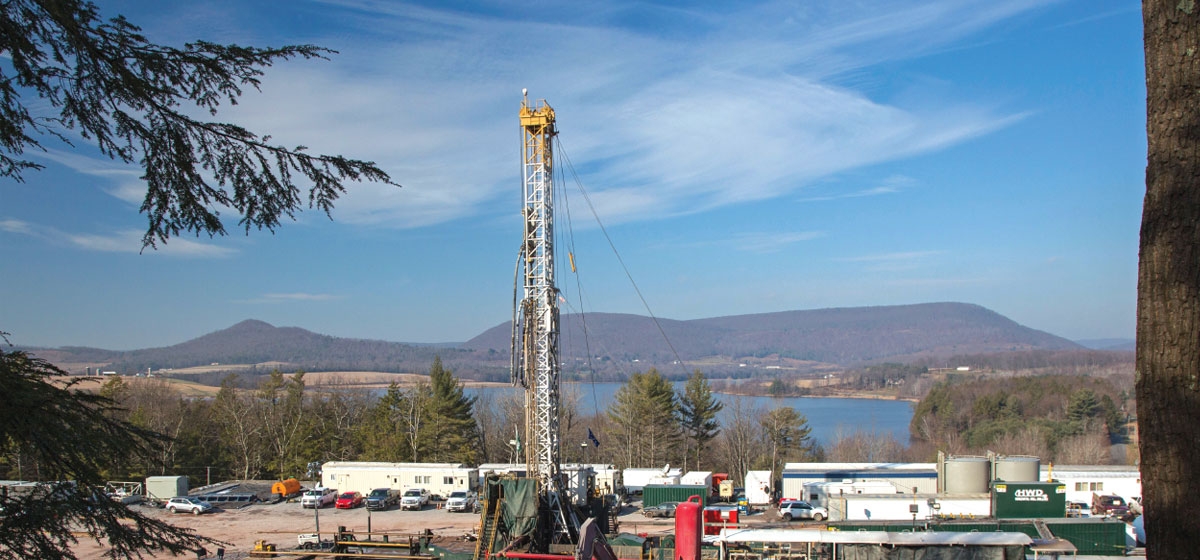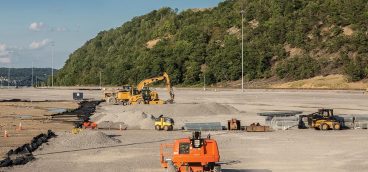
All over rural pennsylvania, motel parking lots, which just a couple of years ago were teeming with lumbering pickup trucks with out-of-state plates, are nearly empty. So are the hastily constructed “man camps” that not so long ago provided temporary shelter for roughnecks and roustabouts. So are the breakfast joints where they used to eat. And from Washington County to the New York state line, hills that until recently rumbled with the sounds of more than 100 drill rigs have gone almost silent.
Welcome to the post-boom Marcellus.
There’s nothing particularly unique about boom and bust cycles in the oil and natural gas industry. Ever since Col. Edwin Drake drilled his first oil well in Titusville in 1859, only to see prices—and production—crash three years later, cycles of rapid expansion, often driven by a technological breakthrough and buoyed by rising prices, have been followed by deep and often devastating declines in both prices and production.
Most drillers will tell you that those cycles are imprinted in the industry’s DNA, that they expect a wild ride, a suddenly rising tide that will lift all boats at the beginning of a boom, and leave more than a few of them dashed against petroleum-bearing rocks at the end. That’s how the industry has always sorted the winners from the losers.
But even by that harsh, Darwinian standard, the so-called “shale revolution” that released a staggering amount of previously unreachable oil and gas was unusually explosive in its ascent, and terrifyingly precipitous in its descent. Nowhere was the volatility of that cycle more evident than in the Appalachian gas fields of the Marcellus.
In fact, said Marcellus Shale Coalition president Dave Spigelmyer, who was the former head of Marcellus operations for Chesapeake Energy, a once-formidable drilling company that is now struggling just to stay alive, the volatility of the Marcellus took even the most sanguine drillers by surprise.
There were, he said, a variety of reasons for that. The Marcellus boom really hit its stride just as the nation was getting up from the mat after the Great Recession, the worst hit the economy had taken since the Great Depression, and for many, the rich rocks of the Marcellus offered an opportunity to drill out of despair. As high as hopes were for the Marcellus when drilling first began just over a decade ago, no one in the industry fully appreciated just how gas-rich the rocks underlying Pennsylvania were, or how efficiently advances in horizontal drilling and hydraulic fracturing would be at releasing that gas.
“We have some of the best rock in the world here in Pennsylvania,” Spigelmyer said, but that has been a double-edged sword. “I don’t think people saw that wells that were projected to [produce] 4 billion cubic feet of gas were going to be 10 or 12 billion cubic-foot wells.”
It wasn’t just the richness of the rock that presaged the dramatic decline from a high of $13.71 per thousand cubic feet of gas at the beginning of the boom to a bargain-basement price of around $1.29 this spring. There were other factors as well. For one thing, in the headlong rush to stake its claims in the Marcellus and to develop the leases, the industry overlooked the fact that the infrastructure needed to get that gas to market—pipelines, both local and regional— hadn’t kept pace. Nor did the industry anticipate that environmentalists and community activists—alarmed by reports of leaks and spills and the environmental risks associated with drifting methane—would be as effective as they’ve been in slowing, and in some cases, derailing pipeline projects.
Even the drive to export gas, which the industry had hoped would buoy natural gas prices in the U.S. by linking them to global prices for the commodity, has lost some of its luster since the Saudis and other petroleum-producing states have flooded the markets in Europe and Asia with stubbornly low-priced oil and gas, a situation that is only expected to get more acute as sanctions are lifted on Iran, one of the world’s most gas-rich states.
Add to that the fact that renewables, apart from hydro, doubled between 2000 and 2014 and now account for about 10 percent of all the electricity produced in the U.S., and you begin to understand why gas from the Marcellus, which once traded at a markup of more than 60 cents per thousand cubic feet over the national benchmark price, is now trading at a discount of 75 cents.
The impact of the downturn in drilling has been profound. Industrywide, about 80 oil and gas or related companies declared bankruptcy in 2015 alone. Earlier this year, Penn Virginia, one of the oldest energy companies in the state, which had been active in Texas and has large holdings in the Marcellus, declared Chapter 11 bankruptcy. The company cited the global plunge in energy prices as the cause.
But the impact goes far beyond the drillers.
While drilling accounts for about 1 percent of the jobs in Pennsylvania directly, the associated industries, everything from steel manufacturers to sandwich makers, are also feeling the squeeze, as evidenced by the fact that for the three straight months ending in April, unemployment inexorably ticked up in Pennsylvania to 5.8 percent, more than a full percentage point higher than the national average. Suffering also are the landowners who have seen their royalty checks dwindle, in some cases to almost nothing. And so are the local governments, counties and municipalities, which can expect to see their shares of Act 13 money, funds collected from the industry and distributed throughout the state, drop by 17 percent.
That’s not to say that prices won’t recover over time. In fact, most analysts expect that as the glut grinds down, gas will likely trade at somewhere around $3.25 by the first quarter of 2018.
But even the most ardent supporters of the industry aren’t expecting a spectacular rebound, and fewer still expect anything like a return to the go-go days of the early years of the Marcellus boom.
There remains a tremendous amount of pent-up production that has to be relieved first. Of the roughly 9,000 wells that have been drilled in Pennsylvania, nearly a quarter of them—more than 2,100—are either waiting for better market conditions before they’re completed, are awaiting pipelines, or are just shut in while the drillers wait for better times. “That’s a fair percentage of the wells that are out there,” Spigelmyer said.
And even if the anticipated rebound occurs as predicted, technological advances in drilling operations mean that it’s not likely that you’ll see 115 rigs operating across the state—as there were in 2011 (there are 16 operating currently)— any time soon.
[Even] the most ardent supporters of the industry aren’t expecting a spectacular rebound, and fewer still expect anything like a return to the go-go days of the early years of the Marcellus boom.
As Travis Windle, managing director at FTI Consulting, a communications firm that serves the industry including the Marcellus Shale Coalition, noted, wells that used to tie up a rig for 30 days can now be drilled in a week. That means fewer rigs, at least in the short term. And fewer rigs means fewer roughnecks and engineers, and less work for all of those related industries that depend on them.
All of which begs the question: Was there a way to have girded ourselves against the vagaries and volatility of a boom-and-bust cycle, even if we didn’t understand in the beginning how explosive the boom and precipitous the bust would be?
Lisa Cessna, executive director of the Washington County Planning Commission, where the Marcellus boom really began a decade ago, believes so, and her prescription for smoothing the rough edges off the cycle is to treat both the boom and the bust with an equal measure of caution and skepticism.
“I’m not necessarily sure that I agree that we’re in a bust,” she said. “I think the industry came on hard and fast after they discovered this resource, kind of jockeying for position… It seemed that it was not sustainable from the outset…There has definitely been a decline of activity, but I don’t know if I’d describe it as a bust. I think it’s just a more natural level of activity.”
“They’re going to be ramping up again, I assume, in the next couple of years, but not at the same levels that they came in here.”
Having anticipated that cycle, Washington County adopted a kind of “seven fat years, seven lean years” approach to revenue, not just with the Act 13 revenues the county received from the state, but with the leases signed on county-owned land. That revenue was carefully husbanded, she said; used when necessary for road improvements, but also for improvements to parks and recreation, amenities that create their own economic benefits, and to reduce the need for bonding or tax increases.
The driving principle, she said, was to save, invest in improvements, take the pressure off the general fund, and do it with the clear understanding that “the money you’re receiving is definitely going to slow down at some point.”
That’s a model that would need to be expanded far beyond investments in parks and recreation if the worst effects of the next bust are to be avoided, said Robert Dunn, associate professor of economics and business at Washington & Jefferson College, who has extensively studied the development of the Marcellus. As in past boom-bust cycles, in the early days of the Marcellus the focus was on the resource itself, not on ways to leverage the resource to attract other diversified industries, and to create a skilled and educated workforce that could weather wild swings in the commodity market. In those heady first years of the boom, he said, “what was built was built to deal with that initial surge. It clearly wasn’t built to deal with the long-term economic growth of those communities,” inside and outside the boundaries of the Marcellus Shale play. It’s understandable, he said. “People saw a short-term opportunity and I guess they wanted to take it.”
But the lesson of the downturn is clear, Dunn said. If the state is going to break out of the boom-and-bust cycles that have bedeviled energy production since the days of Col. Drake, it needs to find a way for stakeholders—the industry, government, the workforce—to use both the resource and the revenue it produces to build a more diversified economy. “Getting different industries that can make use of this resource—chemical companies and industries that use natural gas as a really important input—would be huge.” He added that focusing proposed pipeline construction towards rust belt cities in Pennsylvania, where those industries could take root rather than “exporting that resource to another region” would be a solid step in that direction.
“That’s something you could do. Then whatever happens in the [natural gas] industry, you’d have these local industries that would use it regularly… and that lends stability. Then, if you have trouble in one sector, you wouldn’t expect them all to struggle at the same time.”
It’s not a particularly revolutionary idea, certainly not as revolutionary as the factors that drove the Marcellus boom in the first place, he said, adding that it’s been on the back burner since the boom first began. There have been some steps taken in that direction. Five years after it was first proposed, Shell Chemical Appalachia LLC will build an ethane cracker in Beaver County. It could produce up to 600 jobs and is expected to go on line sometime in the beginning of the next decade.
But to be really effective, that cracker would have to be part of a larger strategy to lure industries to the region and sustain them.
From the beginning, Dunn said, “that was all the talk. That was what was going to happen. But it hasn’t.”
Maybe next time, it will.





